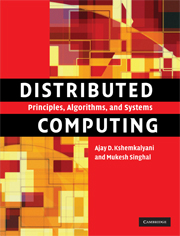Book contents
- Frontmatter
- Contents
- Preface
- 1 Introduction
- 2 A model of distributed computations
- 3 Logical time
- 4 Global state and snapshot recording algorithms
- 5 Terminology and basic algorithms
- 6 Message ordering and group communication
- 7 Termination detection
- 8 Reasoning with knowledge
- 9 Distributed mutual exclusion algorithms
- 10 Deadlock detection in distributed systems
- 11 Global predicate detection
- 12 Distributed shared memory
- 13 Checkpointing and rollback recovery
- 14 Consensus and agreement algorithms
- 15 Failure detectors
- 16 Authentication in distributed systems
- 17 Self-stabilization
- 18 Peer-to-peer computing and overlay graphs
- Index
5 - Terminology and basic algorithms
Published online by Cambridge University Press: 05 June 2012
- Frontmatter
- Contents
- Preface
- 1 Introduction
- 2 A model of distributed computations
- 3 Logical time
- 4 Global state and snapshot recording algorithms
- 5 Terminology and basic algorithms
- 6 Message ordering and group communication
- 7 Termination detection
- 8 Reasoning with knowledge
- 9 Distributed mutual exclusion algorithms
- 10 Deadlock detection in distributed systems
- 11 Global predicate detection
- 12 Distributed shared memory
- 13 Checkpointing and rollback recovery
- 14 Consensus and agreement algorithms
- 15 Failure detectors
- 16 Authentication in distributed systems
- 17 Self-stabilization
- 18 Peer-to-peer computing and overlay graphs
- Index
Summary
In this chapter, we first study a methodical framework in which distributed algorithms can be classified and analyzed. We then consider some basic distributed graph algorithms. We then study synchronizers, which provide the abstraction of a synchronous system over an asynchronous system. Finally, we look at some practical graph problems, to appreciate the necessity of designing efficient distributed algorithms.
Topology abstraction and overlays
The topology of a distributed system can be typically viewed as an undirected graph in which the nodes represent the processors and the edges represent the links connecting the processors. Weights on the edges can represent some cost function we need to model in the application. There are usually three (not necessarily distinct) levels of topology abstraction that are useful in analyzing the distributed system or a distributed application. These are now described using Figure 5.1. To keep the figure simple, only the relevant end hosts participating in the application are shown. The WANs are indicated by ovals drawn using dashed lines. The switching elements inside the WANs, and other end hosts that are not participating in the application, are not shown even though they belong to the physical topological view. Similarly, all the edges connecting all end hosts and all edges connecting to all the switching elements inside the WANs also belong to the physical topology view even though only some edges are shown.
- Type
- Chapter
- Information
- Distributed ComputingPrinciples, Algorithms, and Systems, pp. 126 - 188Publisher: Cambridge University PressPrint publication year: 2008



